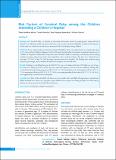Please use this identifier to cite or link to this item:
https://hdl.handle.net/20.500.14356/1207| Title: | The Risk Factors of Cerebral Palsy among the Children Attending a Children’s Hospital |
| Authors: | Mishra, Tulashi Adhikari Shrestha, Sarala Manandhar, Bina Prajapati Sharma, Pratima |
| Citation: | MishraT. A., Shrestha S., Prajapati Manandhar B., & Sharma P. (2022). The Risk Factors of Cerebral Palsy among the Children Attending a Children’s Hospital. Journal of Nepal Health Research Council, 19(04), 778-783. https://doi.org/10.33314/jnhrc.v19i04.3808 |
| Issue Date: | 2021 |
| Publisher: | Nepal Health Research Council |
| Article Type: | Original Article |
| Keywords: | Cerebral palsy children risk factors |
| Series/Report no.: | Oct-Dec, 2021;3808 |
| Abstract: | Abstract Background: Cerebral Palsy is a disorder of movement and posture caused by nonprogressive abnormal brain function. It is a lifelong condition and one of the most common causes of physical disability in children. The objective of this study was to find out the risk factors associated with cerebral palsy among children. Methods: A case control study was carried out among 330 children where cases and controls were taken in the ratio of 1:2. Cases included children diagnosed with cerebral palsy and attending neurological out-patient department of a Children’s Hospital in Kathmandu, Nepal and control included children not having cerebral palsy and attending medical out-patient department of the same hospital for other medical problems. The data were collected from November 29, 2017 to May 20, 2018 by using a pretested interview schedule. The findings were analyzed using frequency, percentage, mean, standard deviation and chi square test and odds ratio. Results: Findings revealed that about one-fourth (24.5%) cases were diagnosed to have CP within one year of age. In terms of sex majority (63.6%) of the cases were male and majority were the first born children. Findings also revealed that infection during pregnancy (OR:2.9, CI: 1.1-7.5), family history of cerebral palsy (OR:5.6, CI: 1.4-21.8), instrumental delivery (OR: 10.9, CI:2.3-50.6), not crying immediately after birth (OR: 17.3, CI: 8.6-34.6), were significantly associated with cerebral palsy. Conclusions: Most of the identified risk factors are preventable and controllable through proper antenatal and skilled intranatal care. Thus, every pregnant woman should receive proper care during pregnancy as well as during delivery for the prevention of the identified risk factors. Keywords: Cerebral palsy; children; risk factors |
| Description: | Original Article |
| URI: | http://103.69.126.140:8080/handle/20.500.14356/1207 |
| ISSN: | Print ISSN: 1727-5482; Online ISSN: 1999-6217 |
| Appears in Collections: | Vol. 19 No. 04 (2021): Vol 19 No 4 Issue 53 Oct-Dec 2021 |
Files in This Item:
| File | Description | Size | Format | |
|---|---|---|---|---|
| 3808-Manuscript-26789-1-10-20220313.pdf | Fulltext Download | 225.49 kB | Adobe PDF |  View/Open |
Items in DSpace are protected by copyright, with all rights reserved, unless otherwise indicated.
